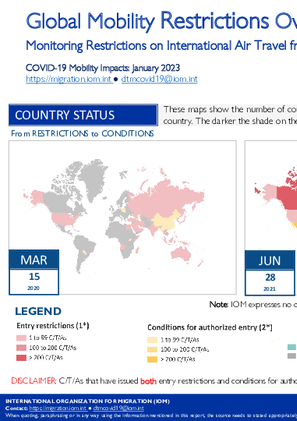-
Countries
-
Data and Analysis
-
Special Focus
-
Crisis Responses
DTM (COVID-19) Global Mobility Restrictions Overview: March 2020 - January 2023

Contacter
DTMcovid19@iom.int
Langue
English
Emplacement
Global
Période couverte
Mar 10 2020
Dec 19 2022
Activité
- Other
The DTM Global Mobility Restrictions Overview began documenting how international air travel restrictions and conditions for authorized entry evolved as of March 2020 when COVID-19 was declared a global pandemic. Using IATA Timatic Coronavirus Outbreak Updates, DTM has documented how each country, territory or area (C/T/A) changed its entry restrictions in line with public health-related immigration and border management measures. Data was collected from 229 C/T/As (Arrival C/T/A) showing the different types of travel measures and accompanying exceptions placed on a total of 247 C/T/As (Restricted CTAs). As the situation evolved, DTM data collection showed emerging trends in the post COVID-19 mobility restrictions and conditions for entry. The Global Mobility Restrictions Overview has provided information intended to support IOM missions and partners in targeted response planning and advocacy for vulnerable populations who may have been affected by changes in global mobility. Since the onset of the COVID-19 pandemic, C/T/As responded to rising infection rates with a series of measures restricting global mobility.
These ranged from entry restrictions (passenger bans on travellers arriving from specific C/T/As and flight suspensions) to a series of conditions for authorized entry which individual passengers had to meet in order to enter a C/T/A by air travel. These conditions included medical measures (COVID-19 test and/or vaccination certificates, quarantine and other health-related requirements) as well as changes to visa/other documentation requirements and passenger registration and tracking tools monitoring arrivals after entry. Data was also collected on the accompanying exceptions that made certain groups of individuals exempt from travel measures (for example, nationals and residents or children under 18 years old). Most recently, since April 2022, entry restrictions and conditions for authorized entry have gradually been lifted and air travel has become less restricted.
Throughout the development of the COVID-19 pandemic, governments have had varying responses to the virus spread either through trying to contain it, delay its arrival or minimize the number of infections overall (MPI, 2022). As restrictive travel measures due to COVID-19 have progressively declined globally, DTM is ending its data collection on COVID-19 mobility impacts. This final report details the most significant events and the regional and global trends on the issuing of entry restrictions, conditions for authorized entry and the respective exception groups that shaped COVID-19’s impact on global mobility.
